Comparing the Applicability of Commonly Used Hydrological Ecosystem Services Models for Integrated Decision-Support
Abstract
:1. Introduction
2. Materials and Methods
2.1. Study Area and Database
2.2. Software Used to Model Hydrological Ecosystem Services
2.3. Methodology-Application of the Models, Data Pre- and Post-Processing
3. Results
4. Discussion
5. Conclusions
Acknowledgments
Author Contributions
Conflicts of Interest
Appendix A
| Variable | Definition | Obtained from or Calculated by |
|---|---|---|
| HYDGRP | Soil hydrological group (A, B, C, D), based on infiltration characteristics | Determination suggested by Arnold et al. [40] but required data not available; therefore simplified determination proposed by Environment and Natural Resources Trust Fund (n.d.) using soil texture provided by HWSD |
| SOL_ZMX | Maximum rooting depth of the soil profile (mm) | Reference soil depth (REF_DEPTH from HWSD, 1000 mm), because no other data available |
| SOL_Z1,2 | Depth from soil surface to bottom of layer (mm) | Topsoil (300 mm) and subsoil depth (700 mm) of HWSD |
| SOL_BD1,2 | Moist bulk density (Mg/m3 or g/cm3) | Reference bulk density from HWSD calculated with equation from Saxton and Rawls [43] (T/S_REF_BULK_DENSITY) |
| SOL_AWC1,2 | Available water capacity of the soil layer (mm H2O/mm soil) | Calculated by SPAW—Soil Water Characteristics [44] |
| SOL_K1,2 | Saturated hydraulic conductivity (mm/h) | Calculated by SPAW—Soil Water Characteristics [44] |
| SOL_CBN1,2 | Organic carbon content (% soil weight) | T_OC and S_OC from HWSD |
| SOL_CLAY1,2 | Clay content (% soil weight) | T_CLAY and S_CLAY from HWSD |
| SOL_SILT1,2 | Silt content (% soil weight) | T_SILT and S_SILT from HWSD |
| SOL_SAND1,2 | Sand content (% soil weight) | T_SAND and S_SAND from HWSD |
| SOL_ROCK1,2 | Rock fragment content (% total weight) | T_GRAVEL and S_GRAVEL from HWSD |
| SOL_ALB1 | Moist soil albedo | Calculated by the equation from Post et al. (2000): with data from [45] |
| USLE_K1 | USLE equation soil erodibility K factor | Calculated with the equations of Williams [46] given in [40] using the sand, silt, clay and organic carbon content |
| Data | Definition | Obtained from or Calculated by |
|---|---|---|
| Average annual rainfall | Mean annual rainfall depth in mm for each cell | WorldClim (Bioclimatic variables for tile 23), annual average from 1960–1990 [27] |
| Rainfall depth or precipitation of wettest month | Rainfall depth influences the amount of runoff of each cell. If the rainfall depth is not available, the mean precipitation of the wettest month can be used (mm) [33] | WorldClim (Bioclimatic variables for tile 23), annual average from 1960–1990 [27] |
| Mean annual actual evapotranspiration (AET) | Mean annual values for each cell in mm | CGIAR-CSI, annual average from 1950–2000 [28] |
| Reference evapotranspiration (only InVEST) | Average annual reference evapotranspiration—in mm—being the potential loss of water from soil evaporation and alfalfa/grass transpiration if sufficient water is available; the equations (Penman-Monteith, Hargreaves etc.) for potential evapotranspiration (PET) are suggested, therefore the PET raster of CGIAR-CSI can be used | CGIAR-CSI, annual average potential evapotranspiration from 1950–2000 [47] |
| Rainfall erosivity | Rainfall erosivity index R depending on the intensity and duration of rainfall in | Calculated using WorldClim data with an equation proposed by Mikhailova et al. [48] |
| Soil erodibility | Soil erodibility K measures the susceptibility of soil particles to erosion in [33] | Calculated using HWSD according to Sharp et al. [32] |
| Soil depth | Average soil depth for each cell in mm | Obtained from HWSD data |
| Soil texture (only RIOS) | Index value for each cell representing the soil texture class | Derived from HWSD |
| Plant available water fraction (only InVEST) | PAWC is the fraction of water stored in the profile and available for plants’ use [33] | Calculated with SWAT input variable SOL_AWC (from SPAW) by adding up the SOL_AWC values across horizons |
| Location and number of beneficiaries (only RIOS) | Location and number of beneficiaries depend on the chosen objective; different raster files for different objectives: erosion control: population density (rural and all beneficiaries); base flow and flood mitigation: population downstream (rural and all) | Calculated with population density [16] |
References
- Crutzen, P.J. Geology of mankind. Nature 2002, 415, 23. [Google Scholar] [CrossRef] [PubMed]
- Millennium Ecosystem Assessment. Ecosystems and Human Well-Being: Synthesis; Island Press: Washington, DC, USA, 2005. [Google Scholar]
- Hack, J. Application of payments for hydrological ecosystem services to solve problems of fit and interplay in integrated water resources management. Water Int. 2015, 40, 929–948. [Google Scholar] [CrossRef]
- Brauman, K.A.; Daily, G.C.; Duarte, T.K.K.; Mooney, H.A. The Nature and Value of Ecosystem Services: An Overview Highlighting Hydrologic Services. Annu. Rev. Environ. Resour. 2007, 32, 67–98. [Google Scholar] [CrossRef]
- Duku, C.; Rathjens, H.; Zwart, S.J.; Hein, L. Towards ecosystem accounting: A comprehensive approach to modelling multiple hydrological ecosystem services. Hydrol. Earth Syst. Sci. 2015, 19, 4377–4396. [Google Scholar] [CrossRef]
- Francesconi, W.; Srinivasan, R.; Pérez-Minana, E.; Willcock, S.P.; Quintero, M.; Pérez-Miñana, E.; Willcock, S.P.; Quintero, M. Using the Soil and Water Assessment Tool (SWAT) to model ecosystem services: A systematic review. J. Hydrol. 2016, 535, 625–636. [Google Scholar] [CrossRef]
- Schmalz, B.; Kruse, M.; Kiesel, J.; Müller, F.; Fohrer, N. Water-related ecosystem services in Western Siberian lowland basins - Analysing and mapping spatial and seasonal effects on regulating services based on ecohydrological modelling results. Ecol. Indic. 2016, 71, 55–65. [Google Scholar] [CrossRef]
- Swallow, B.M.; Sang, J.K.; Nyabenge, M.; Bundotich, D.K.; Duraiappah, A.K.; Yatich, T.B. Tradeoffs, synergies and traps among ecosystem services in the Lake Victoria basin of East Africa. Environ. Sci. Policy 2009, 12, 504–519. [Google Scholar] [CrossRef]
- Hamel, P.; Chaplin-Kramer, R.; Sim, S.; Mueller, C. A new approach to modeling the sediment retention service (InVEST 3.0): Case study of the Cape Fear catchment, North Carolina, USA. Sci. Total Environ. 2015, 524, 166–177. [Google Scholar] [CrossRef] [PubMed]
- Nelson, E.; Mendoza, G.; Regetz, J.; Polasky, S.; Tallis, H.; Cameron, R.; Chan, K.M.A.; Daily, G.C.; Goldstein, J.; Kareiva, P.M.; Lonsdorf, E.; et al. Modeling multiple ecosystem services, biodiversity conservation, commodity production, and tradeoffs at landscape scales. Front. Ecol. Environ. 2009, 7, 4–11. [Google Scholar] [CrossRef]
- Nourani, V.; Roughani, A.; Gebremichael, M. Topmodel capability for rainfall-runoff modeling of the Ammameh watershed at different time scales using different terrain algorithms. J. Urban Environ. Eng. 2011, 5, 1–14. [Google Scholar] [CrossRef]
- Terrado, M.; Acuña, V.; Ennaanay, D.; Tallis, H.; Sabater, S. Impact of climate extremes on hydrological ecosystem services in a heavily humanized Mediterranean basin. Ecol. Indic. 2014, 37, 199–209. [Google Scholar] [CrossRef]
- Bagstad, K.J.; Semmens, D.J.; Waage, S.; Winthrop, R. A comparative assessment of decision-support tools for ecosystem services quantification and valuation. Ecosyst. Serv. 2013, 5, 27–39. [Google Scholar] [CrossRef]
- Bagstad, K.J.; Semmens, D.J.; Winthrop, R. Comparing approaches to spatially explicit ecosystem service modeling: A case study from the San Pedro River, Arizona. Ecosyst. Serv. 2013, 5, 40–50. [Google Scholar] [CrossRef]
- Wheelock Díaz, S.B.; Jackman, M. Análisis Comperativo de Experiencias de Pago por Servicios Ambientals en Nicaragua, 28th ed.; Cuaderno de Investigación; Nitlapan-UCA: Managua, Nicaragua, 2007. [Google Scholar]
- Alcaldía Municipal de León Datos Generales del Municipio León. Available online: http://www.leonmunicipio.com/uploads/1/3/8/2/1382165/datos_generales_del_municipio_de_len.pdf (accessed on 9 November 2016).
- Food and Agriculture Organisation of the United Nations. Available online: http://www.fao.org/nr/water/aquastat/main/index.stm (accessed on 26 January 2018).
- Peralta, M. “Juan Venado”, Tesoro Ecológico. La Prensa. 2000. Available online: https://www.laprensa.com.ni/2000/08/08/departamentales/742574-juan-venado-tesoro-ecolgico (accessed on 26 January 2018).
- Galo Romero, H. Suelos Degradados y Salud en Peligro. 2015. Available online: https://www.elnuevodiario.com.ni/nacionales/358862-suelos-degradados-salud-peligro/ (accessed on 26 January 2018).
- El Espectador Hay Escasez de Agua en 30 de 153 Municipios de Nicaragua. 2015. Available online: https://www.elespectador.com/noticias/medio-ambiente/hay-escasez-de-agua-30-de-153-municipios-de-nicaragua-articulo-556584 (accessed on 26 January 2018).
- Silva, J.A. Sed en Nicaragua, el País en que el Agua es Parte de su Nombre|IPS Agencia de Noticias. 2015. Available online: http://www.ipsnoticias.net/2015/05/sed-en-nicaragua-el-pais-en-que-el-agua-es-parte-de-su-nombre/ (accessed on 26 January 2018).
- López Hernández, E. León Vulnerable ante Desastres. 2011. Available online: https://www.laprensa.com.ni/2010/01/25/departamentales/14160-leon-vulnerable-ante-desastres-naturales (accessed on 26 January 2018).
- Lehner, B.; Verdin, K.; Jarvis, A. HydroSHEDS. Technical Documentation: Version 1.0; USGS Earth Resources Observation and Science: Sioux Falls, SD, USA, 2006.
- European Space Agency (ESA). Université Catholique de Louvain GlobCover 2009 Project 2010. Available online: http://due.esrin.esa.int/page_globcover.php (accessed on 26 January 2018).
- Global Weather Data for SWAT: National Centers for Environmental Prediction (NCEP) Climate Forecast System Reanalysis (CFSR) Data. 2016. Available online: https://globalweather.tamu.edu/ (accessed on 26 January 2018).
- Nachtergaele, F.O.; van Velthuizen, H.; Verelst, L.; Batjes, N.H.; Dijkshoorn, J.A.; van Engelen, V.W.P.; Fischer, G.; Jones, A.; Montanarella, L.; Petri, M.; et al. Harmonized World Soil Database: Version 1.2; Food and Agriculture Organization of the United Nations: Rome, Italy, 2012. [Google Scholar]
- Hijmans, R.J.; Cameron, S.E.; Parra, J.L.; Jones, P.G.; Jarvis, A. Very high resolution interpolated climate surfaces for global land areas. Int. J. Climatol. 2005, 25, 1965–1978. [Google Scholar] [CrossRef]
- Trabucco, A.; Zomer, R.J. Global Soil Water Balance Geospatial Database 2010. Available online: http://www.cgiar-csi.org (accessed on 26 January 2018).
- Arnold, J.G.; Srinivasan, R.; Muttiah, R.S.; Williams, J.R. Large Area Hydrologic Modeling and Assessment PartI: Model Development. J. Am. Water Resour. Assoc. 1998, 34, 73–89. [Google Scholar] [CrossRef]
- Arnold, J.G.; Fohrer, N. SWAT2000: Current capabilities and research opportunities in applied watershed modelling. Hydrol. Process. 2005, 19, 563–572. [Google Scholar] [CrossRef]
- Goldman, R.L.; Tallis, H. A Critical Analysis of Ecosystem Services as a Tool in Conservation Projects the Possible Perils, the Promises, and the Partnerships. Ann. N. Y. Acad. Sci. 2009, 1162, 63–78. [Google Scholar] [CrossRef] [PubMed]
- Sharp, R.; Tallis, H.T.; Ricketts, T.; Guerry, A.D.; Wood, S.A.; Chaplin-Kramer, R.; Nelson, E.; Ennaanay, D.; Wolny, S.; Olwero, N. InVEST User Guide. 2016. Available online: http://data.naturalcapitalproject.org/nightly-build/invest-users-guide/html/ (accessed on 26 January 2018).
- Vogl, A.; Tallis, H.; Douglass, J.; Sharp, R.; Wolny, S.; Veiga, F.; Benitez, S.; León, J.; Game, E.; Petry, P.; et al. Resource Investment Optimization System (RIOS): Introduction & Theoretical Documentation. 2015. Available online: http://data.naturalcapitalproject.org/rios_releases/RIOSGuide_Combined_07May2015.pdf (accessed on 26 January 2018).
- Gassman, P.W.; Reyes, M.R.; Green, C.H.; Arnold, J.G. The Soil and Water Assessment Tool: Historical development, applications, and future research directions. Am. Soc. Agric. Biol. Eng. 2007, 50, 1211–1250. [Google Scholar] [CrossRef]
- Neitsch, S.L.; Arnold, J.G.; Kiniry, J.R.; Williams, J.R. Soil and Water Assessment Tool: Theoretical Documentation: Version 2009; Texas Water Resources Institute: Temple, TX, USA, 2009. [Google Scholar]
- Vigerstol, K.L.; Aukema, J.E. A comparison of tools for modeling freshwater ecosystem services. J. Environ. Manag. 2011, 92, 2403–2409. [Google Scholar] [CrossRef] [PubMed]
- Tallis, H.; Polasky, S. Mapping and Valuing Ecosystem Services as an Approach for Conservation and Natural-Resource Management. Ann. N. Y. Acad. Sci. 2009, 1162, 265–283. [Google Scholar] [CrossRef] [PubMed]
- Natural Capital Project. Available online: http://www.naturalcapitalproject.org/ (accessed on 14 September 2016).
- Renard, K.G.; Foster, G.R.; Weesies, G.A.; Porter, J.P. RUSLE: Revised universal soil loss equation. J. Soil Water Conserv. 1991, 46, 30–33. [Google Scholar]
- Arnold, J.G.; Moriasi, D.N.; Gassman, P.W.; Abbaspour, K.C.; White, M.J.; Srinivasan, R.; Santhi, C.; Harmel, R.D.; van Griensven, A.; van Liew, M.W.; et al. SWAT: Model uses, calibration, and validation. Trans. ASABE 2012, 55, 1491–1508. [Google Scholar] [CrossRef]
- Burkhard, B.; Kandziora, M.; Hou, Y.; Müller, F. Ecosystem Service Potentials, Flows and Demands-Concepts for Spatial Localisation, Indication and Quantification. Landsc. Online 2014, 32, 1–32. [Google Scholar] [CrossRef]
- Villa, F.; Bagstad, K.J.; Voigt, B.; Johnson, G.W.; Portela, R.; Honzák, M.; Batker, D. A Methodology for Adaptable and Robust Ecosystem Services Assessment. PLoS ONE 2014, 9, e91001. [Google Scholar] [CrossRef] [PubMed]
- Saxton, K.E.; Rawls, W.J. Soil Water Characteristic Estimates by Texture and Organic Matter for Hydrologic Solutions. Soil Sci. Soc. Am. J. 2006, 70, 1569. [Google Scholar] [CrossRef]
- Saxton, K.E.; Rawls, W.J. SPAW-Soil-Plant-Atmosphere-Water Field and Pond Hydrology: Soil Water Characteristics-Hydraulic Properties Calculator. 2009. Available online: https://hrsl.ba.ars.usda.gov/SPAW/Index.htm (accessed on 26 January 2018).
- Dijkshoorn, K.; Huting, J.; Tempel, P. Update of the 1:5 Million Soil and Terrain Database for Latin America and the Caribbean (SOTERLAC)—Version 2.0; ISRIC—World Soil Information: Wageningen, The Netherlands, 2005. [Google Scholar]
- Williams, J.R. The EPIC model. In Computer Models of Watershed Hydrology; Water Resources Publications: Baton Rouge, LA, USA, 1995; pp. 909–1000. [Google Scholar]
- Zomer, R.J.; Trabucco, A.; Bossio, D.A.; Verchot, L.V.; van Straaten, O.; Verchot, L.V. Climate change mitigation: A spatial analysis of global land suitability for clean development mechanism afforestation and reforestation. Agric. Ecosyst. Environ. 2008, 126, 67–80. [Google Scholar] [CrossRef]
- Mikhailova, E.A.; Bryant, R.B.; Schwager, S.J.; Smith, S.D. Predicting Rainfall Erosivity in Honduras. Soil Sci. Soc. Am. J. 1997, 61, 273. [Google Scholar] [CrossRef]
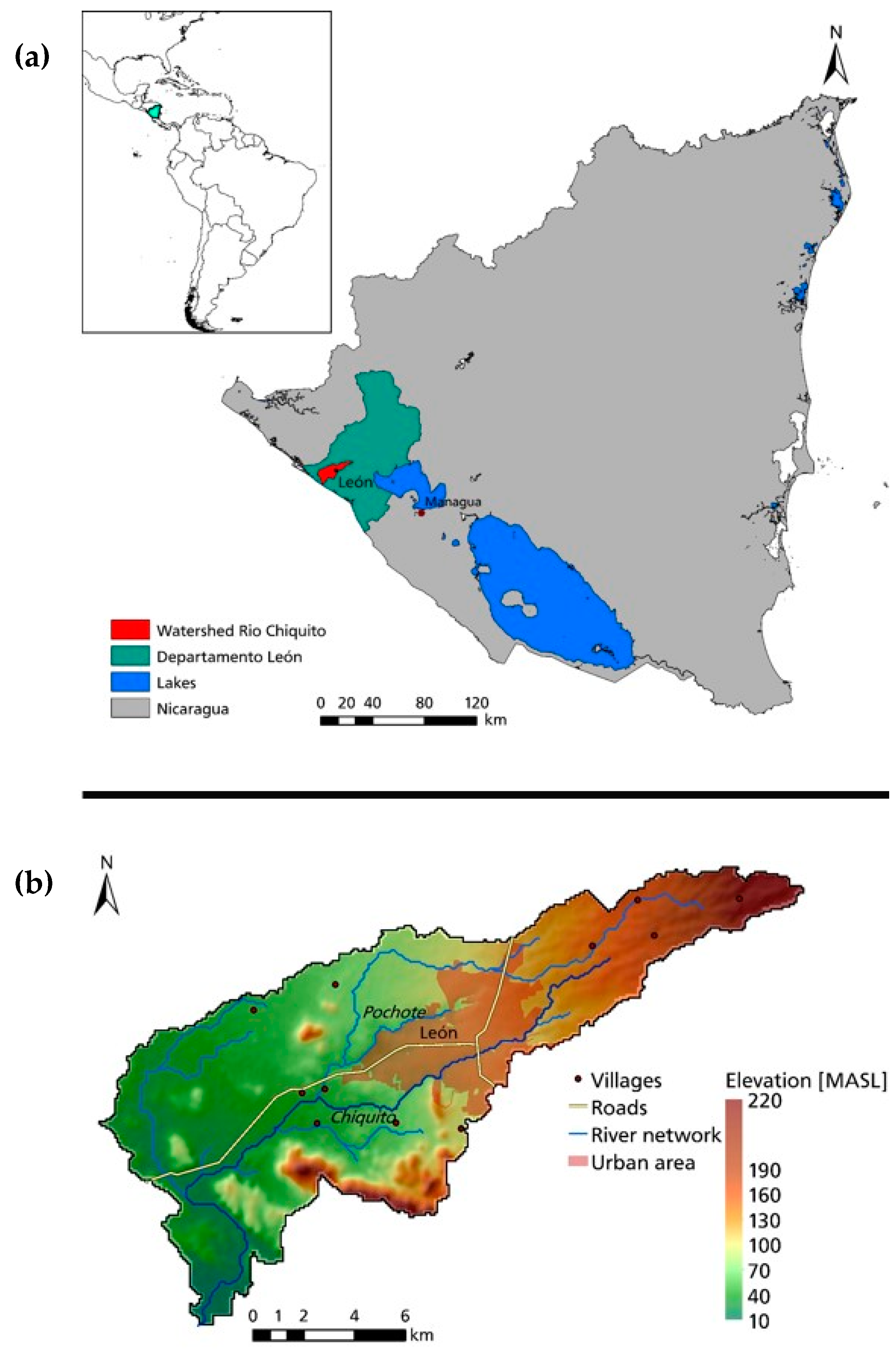
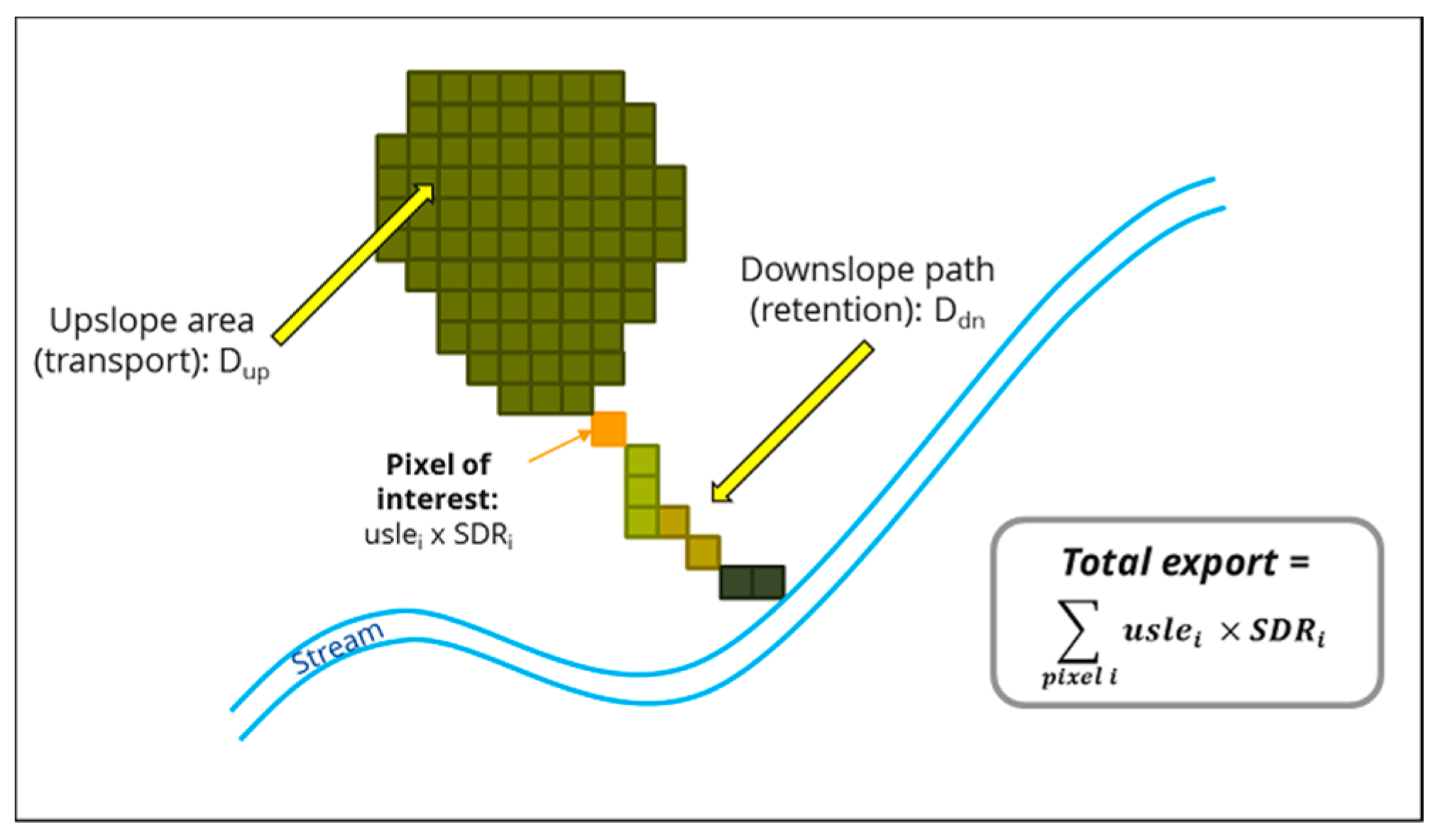
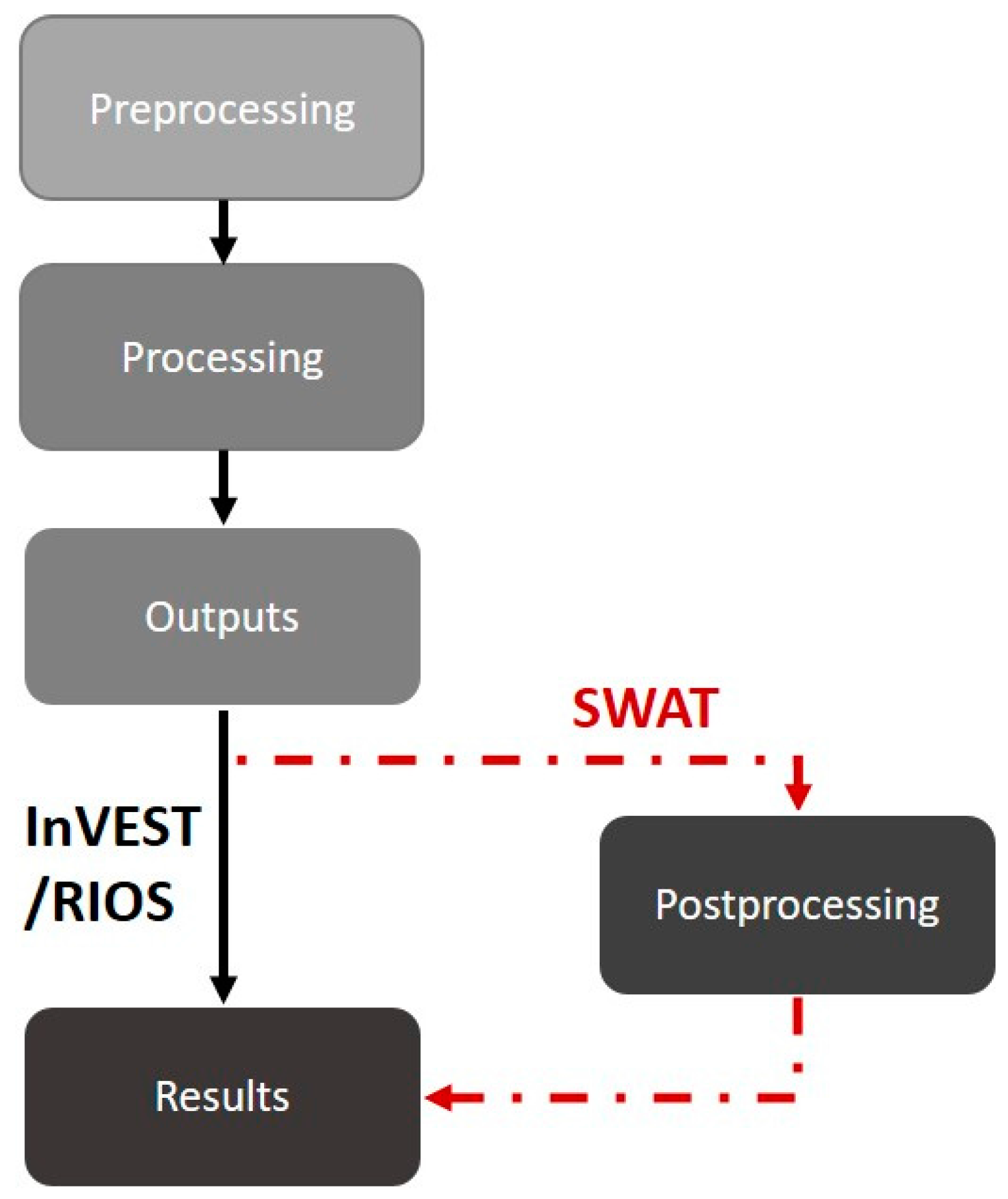
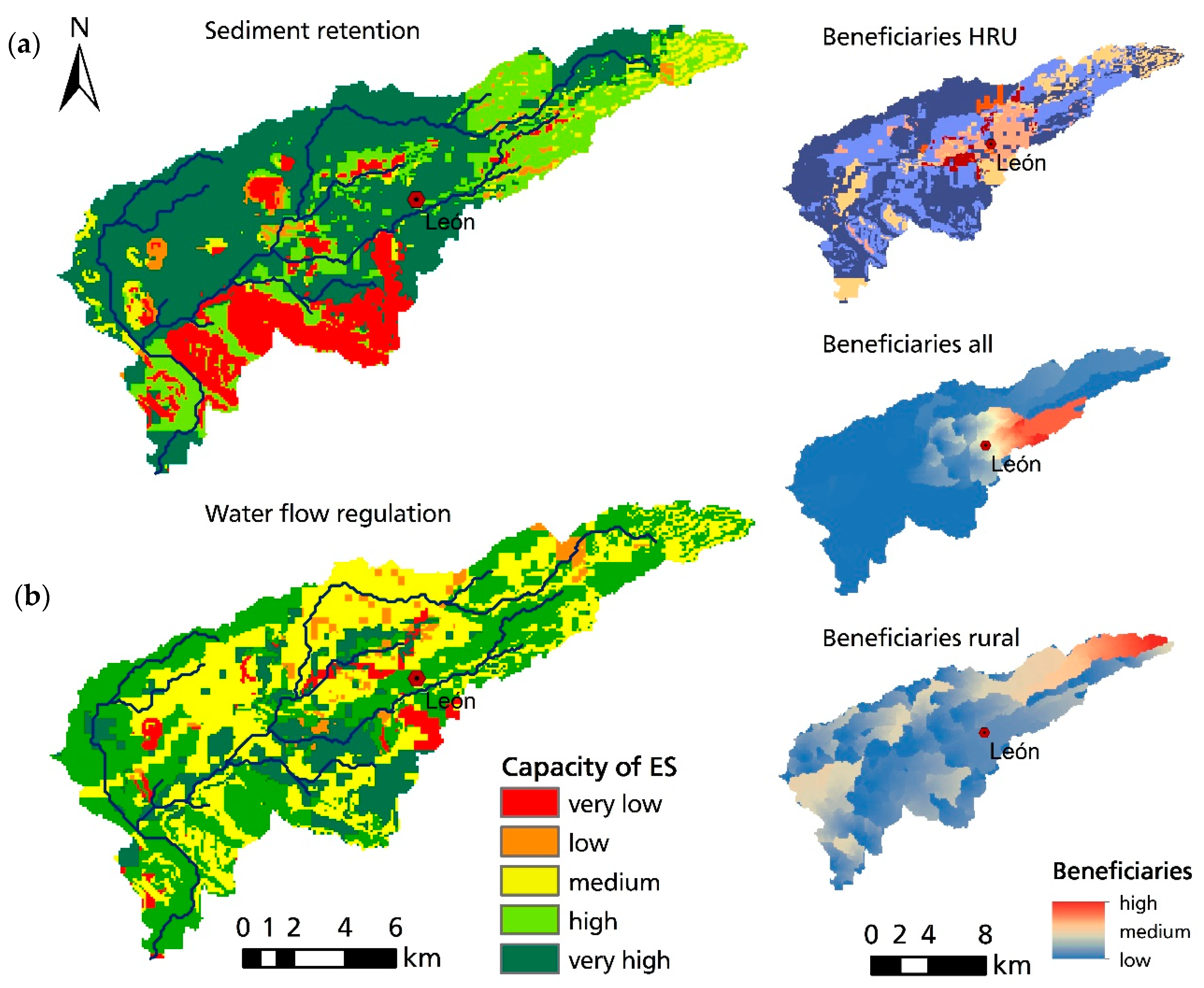
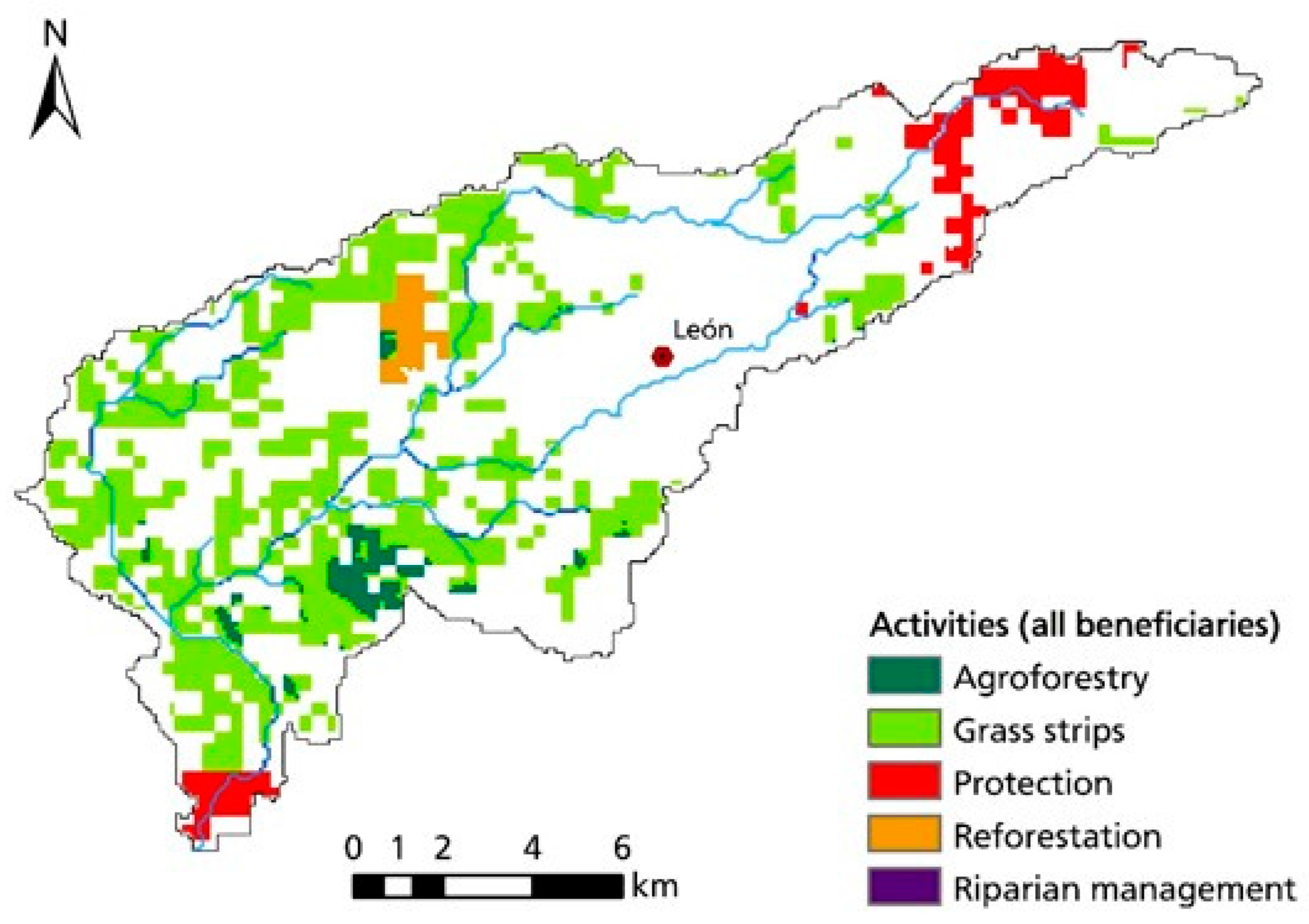
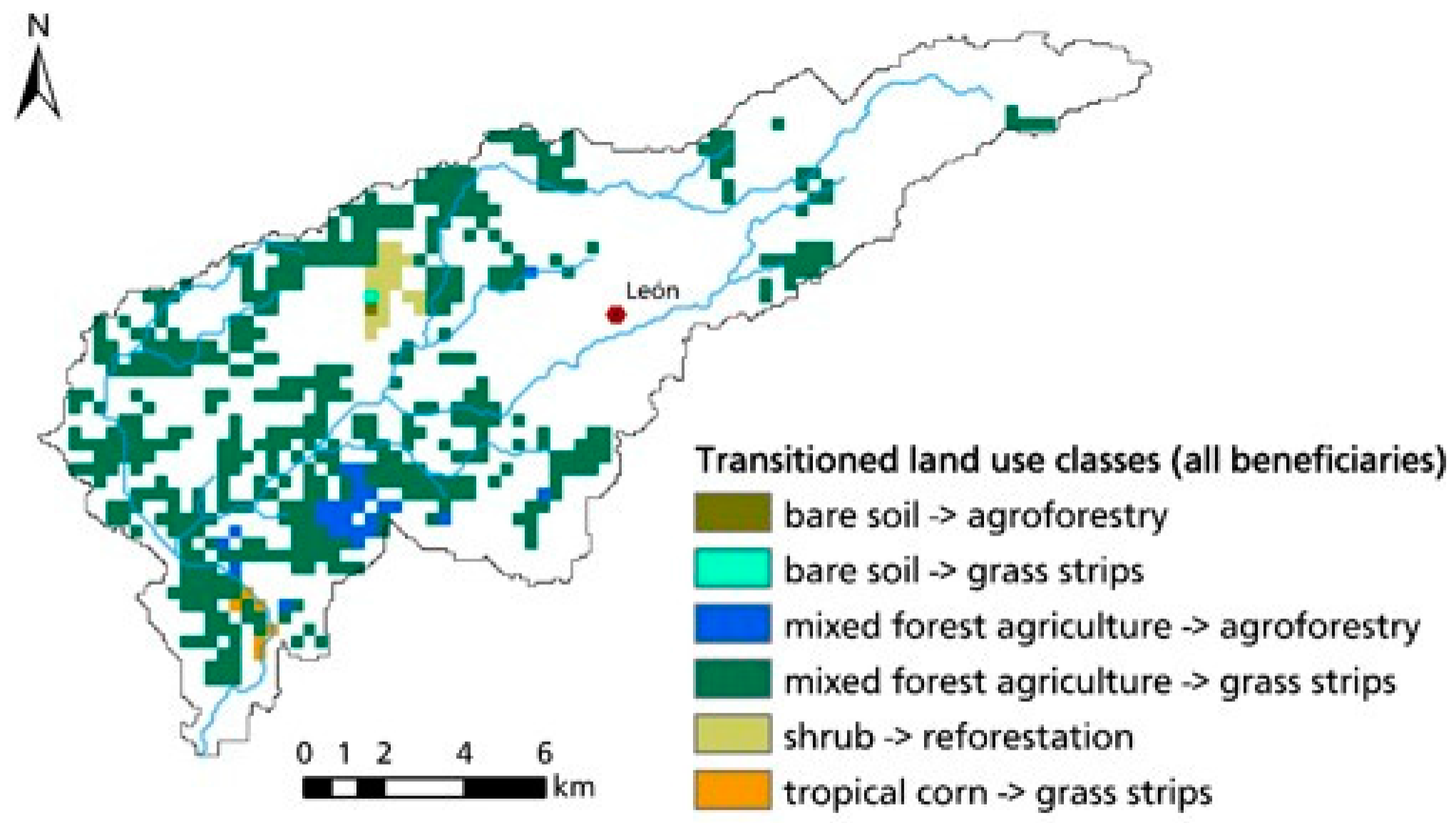

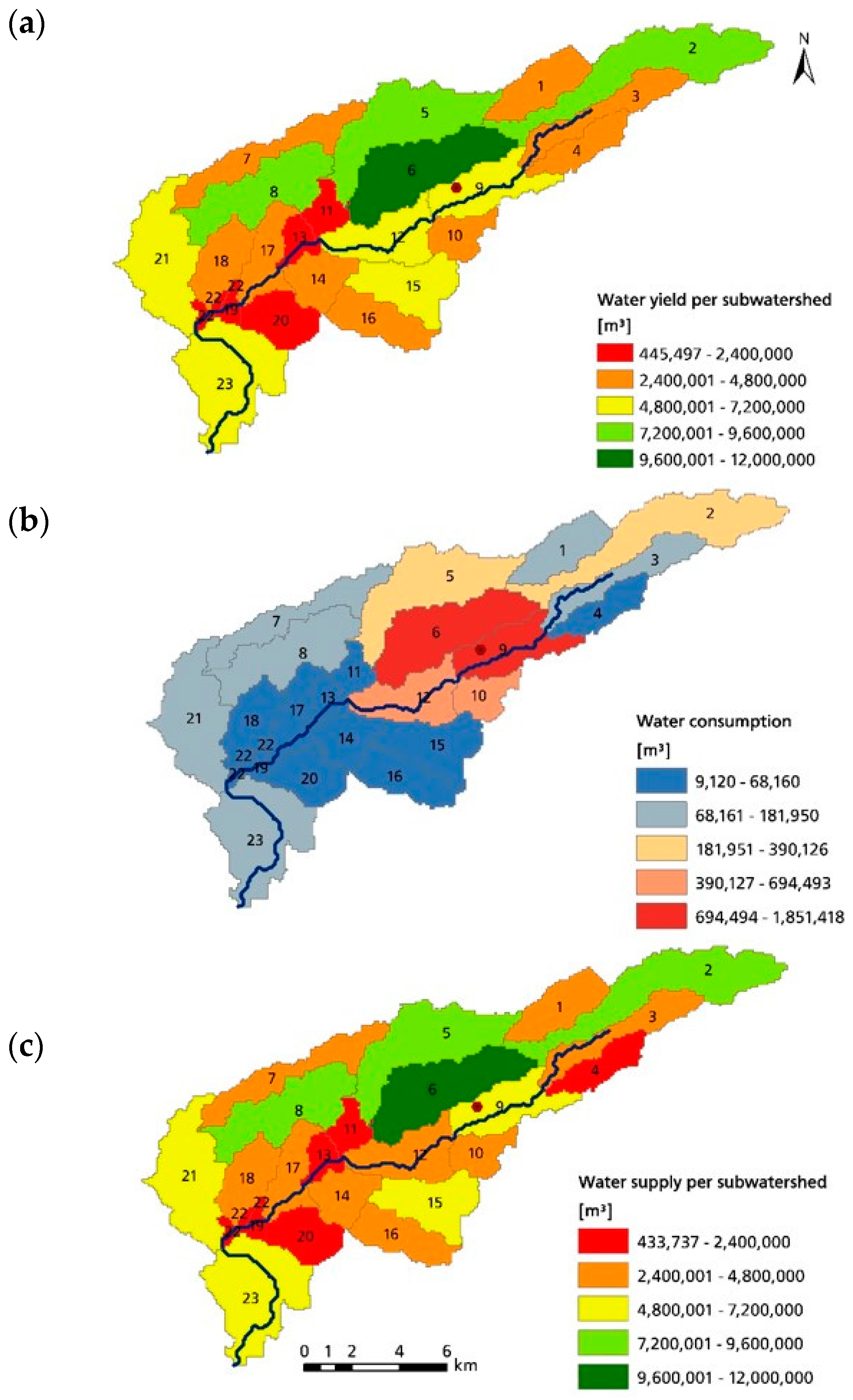
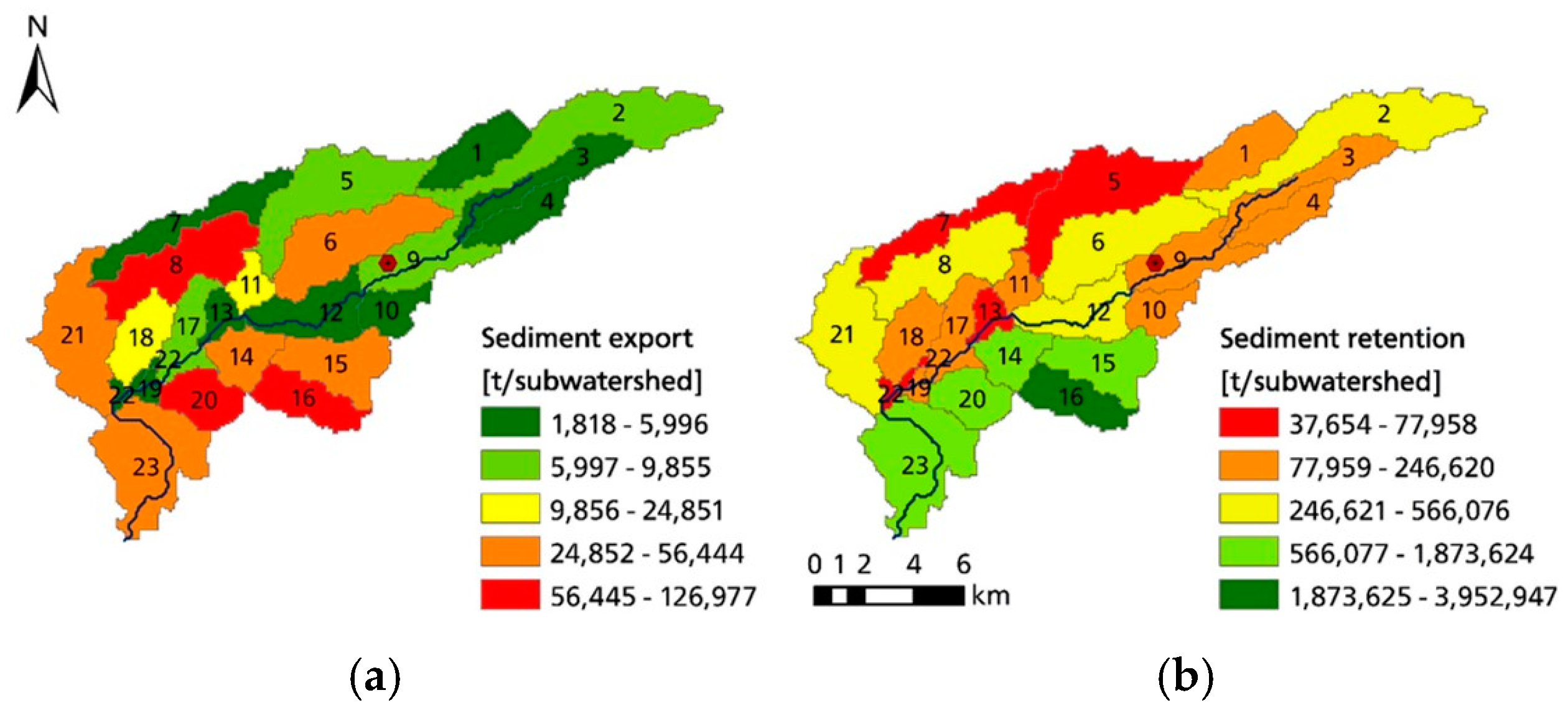


| Data Type (Format) | Source | Resolution | Required for |
|---|---|---|---|
| Biophysical inputs | |||
| Digital elevation model (raster) | USGS HydroSHEDS [23] | 3 arc-seconds → approx. 90 m at equator | InVEST, RIOS, SWAT |
| Land use/land cover (raster) | GlobCover 2009 [24] | 300 m | InVEST, RIOS, SWAT |
| Weather data (gages) | Data from NCEP for 1979–2014 [25] | 2 weather stations | SWAT |
| Soil data (raster and database) | HWSD, [26] | 30 arc-seconds → approx. 1 km | InVEST, RIOS, SWAT |
| Average annual rainfall (raster) | WorldClim, annual average from 1960–1990 [27] | 30 arc-seconds → approx. 1 km | InVEST, RIOS |
| Mean annual actual evapotranspiration (raster) | CGIAR-CSI, annual average from 1950–2000 [28] | 30 arc-seconds → approx. 1 km | RIOS |
| Socio-economic input | |||
| Location & number of beneficiaries (raster) | Calculated with population density [16] | Municipality León | RIOS |
| Per capita water consumption (table) | FAO Aquastat data [17] | Annual average for Nicaragua | InVEST |
| Ecosystem Service Modelled | Variables of the HRU Output File | |
|---|---|---|
| Variable Name | Definition | |
| Water flow regulation | SW_END | Soil water content (mmH2O) at the end of the time period |
| SURQ_CNT | Surface contribution (mmH2O) to streamflow in the main channel during time step | |
| LATQ_GEN | Lateral flow generated in the HRU during time step (mmH2O) | |
| GW_Q | Groundwater contribution to streamflow (mmH2O), also called base flow | |
| Sediment retention | SYLD | Sediment yield transported into the main channel during time step (t/ha) |
| Point of Comparison | SWAT | RIOS | InVEST |
|---|---|---|---|
| Model description | Hydrologic model with different output variables | Implementation of activities to maintain, protect or restore ES | Different models for final and supporting ES used: Water Yield and SDR Model |
| Inclusion of beneficiaries | Cannot be included directly Visual comparison possible | Beneficiaries-raster to weight activity areas | Water yield model uses water demand table |
| Uncertainty | Calibration and valuation possible but for study area no calibration | No option for calibration; comparison of input data with literature values | Calibration possible with sediment load or stream flow but for study area no calibration |
| Data requirements & pre-processing | High data requirement and pre-processing | Medium data requirement and high pre-processing | Medium data requirement and low pre-processing |
| Training effort | Training effort high | Training effort medium to high | Training effort medium |
| Time requirement | High | Medium | Low to medium |
© 2018 by the authors. Licensee MDPI, Basel, Switzerland. This article is an open access article distributed under the terms and conditions of the Creative Commons Attribution (CC BY) license (http://creativecommons.org/licenses/by/4.0/).
Share and Cite
Lüke, A.; Hack, J. Comparing the Applicability of Commonly Used Hydrological Ecosystem Services Models for Integrated Decision-Support. Sustainability 2018, 10, 346. https://doi.org/10.3390/su10020346
Lüke A, Hack J. Comparing the Applicability of Commonly Used Hydrological Ecosystem Services Models for Integrated Decision-Support. Sustainability. 2018; 10(2):346. https://doi.org/10.3390/su10020346
Chicago/Turabian StyleLüke, Anna, and Jochen Hack. 2018. "Comparing the Applicability of Commonly Used Hydrological Ecosystem Services Models for Integrated Decision-Support" Sustainability 10, no. 2: 346. https://doi.org/10.3390/su10020346





